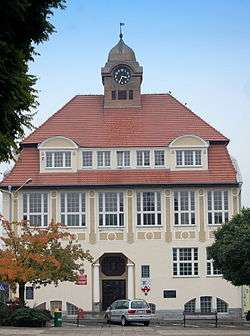Nowogard
| Nowogard | ||
|---|---|---|
 | ||
| ||
 Nowogard | ||
| Coordinates: 53°40′N 15°7′E / 53.667°N 15.117°E | ||
| Country |
| |
| Voivodeship | West Pomeranian | |
| County | Goleniów | |
| Gmina | Nowogard | |
| Area | ||
| • Total | 12.46 km2 (4.81 sq mi) | |
| Population (2006) | ||
| • Total | 16,745 | |
| • Density | 1,300/km2 (3,500/sq mi) | |
| Postal code | 72–200 | |
| Website | http://nowogard.pl | |
Nowogard ([nɔˈvɔɡart]) (German: Naugard; Kashubian: Nowògard) is a town in the West Pomeranian Voivodeship Province of northwestern Poland. As of 2004 it had a population of 16,733.
Name
Nowogard is a combination of two Slavic terms: novi (new) and gard, which is Pomeranian for town, city, or fortified settlement. In this capacity, the term gard (or gôrd) is still being used in the only surviving variation of the Pomeranian language, Kashubian.
Location
Nowogard has been situated in Goleniow County of West Pomeranian Voivodship since 1999, but formerly in Szczecin Voivodship from 1975 to 1998. It is located 60 kilometres (37 mi) northeast of Szczecin and 55 kilometres (34 mi) south of the Baltic coast
History
The city's origins go back to a fortified Slavic settlement which was the seat of the local castellan.[1] The settlement was first mentioned in 1268 as "Nogart" when Barnim I, the Duke of Pomerania granted it as a fief to the Bishopric of Cammin. The bishops erected a castle in the city.[1] In 1274, the town and its surrounding area was administered by Otto von Eberstein, it remained in the possession of the "von Eberstein" family until 1663. In 1309 the town adopted German town law.
In the first half of the 14th century, fortifications were erected with an oblong market square in the center of the town. This is where the town hall and the St. Mary's Church were erected. In 1663, after the death of the last Eberstein, Naugard became property of Ernst Bogislaw von Croÿ and in 1684, property of the electors of Brandenburg.[1]
Throughout the Soviet East Pomeranian Offensive operation of World War II up to 60 percent of Naugard was destroyed.[1] On the March 5, 1945, the town was taken by the Red Army, after which it was Polish territory and the population fled or was expelled from the city and the city was resettled with Poles.
Sights

The city's main tourist attraction is a large lake which extends to the center of Nowogard. Its surface covers 1.12 square kilometres (12,100,000 sq ft) with a length of 2,680 metres (8,790 ft) and a width of 620 metres (2,030 ft). Surrounding forests have mushrooms, berries and game.
Population
- 1875: 4,765 inhabitants
- 1880: 4,949 inhabitants
- 1890: 4,872 inhabitants
- 1925: 6,302 inhabitants
- 1933: 7,356 inhabitants
- 1939: 8,202 inhabitants[2]
- 1960: 6,500 inhabitants
- 1970: 8,800 inhabitants
- 1975: 9,900 inhabitants
- 1980: 11,300 inhabitants
Notable residents
- Friedrich Michael Ziegenhagen (1694–1776), German clergyman, court preacher of George I of Great Britain
International relations
Twin towns — sister cities
Nowogard is twinned with:
In 1963 West Germany (FRG) town of Heide took over a partnership for the expelled populace of Naugard. In 1996 this led to the signing of a contract of partnership between Heide and Nowogard in which the former populace is regarded "constitutive partners".[3]
References
- 1 2 3 4 nowogard.pl (in Polish)
- ↑ verwaltungsgeschichte.de (in German)
- ↑ heide.de (in German)
External links
Coordinates: 53°39′N 15°07′E / 53.650°N 15.117°E
